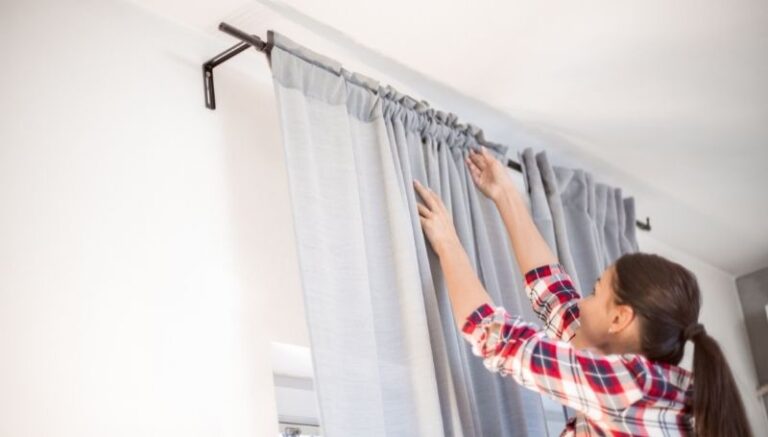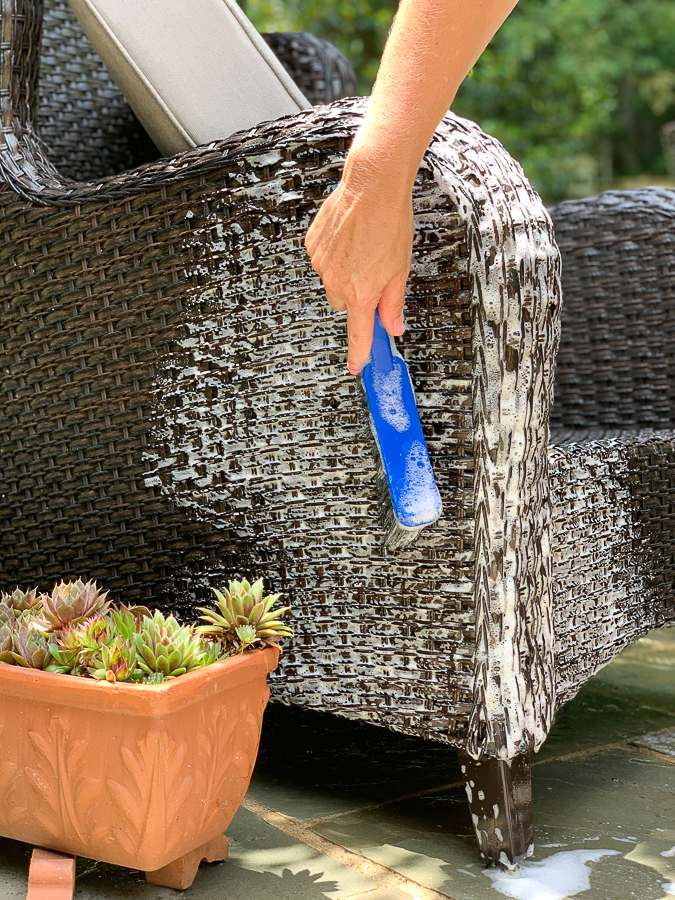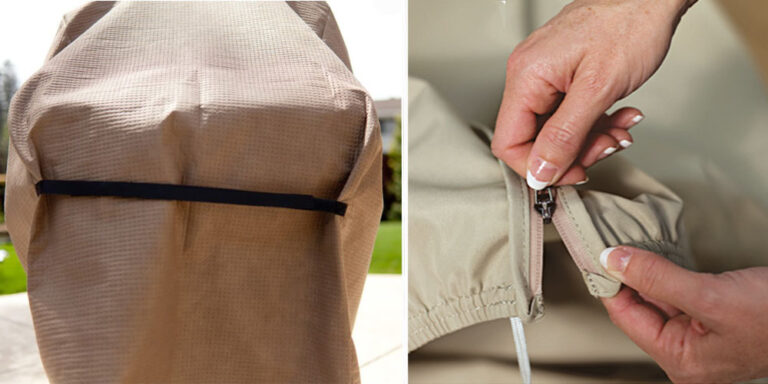Seasonal Care Tips for Small Patio Furniture
Creating a cozy and inviting outdoor space with small patio furniture is one of the best ways to maximize your home’s livable area. But like all things we love, it requires some TLC to keep it looking fresh and lasting longer. Over the years, I’ve discovered a few tricks that not only make my small patio furniture last through the seasons but also keep it looking like new.

Whether you’re gearing up for the chilly winter months or getting ready to bask in the summer sun, here are some essential seasonal care tips for small patio furniture in tip-top shape.
Winter Storage Solutions
Winter can be a tough season for outdoor furniture, especially if you live in an area where temperatures drop below freezing or snow and ice are a regular occurrence. Without proper care, your small patio furniture can suffer damage that might be expensive or even impossible to repair. The key to keeping your pieces safe during the winter is effective storage and protection.
Protecting Your Furniture During Cold Months
One of the biggest mistakes I see people make is leaving their patio furniture out in the cold without proper protection. The cold, combined with moisture, can cause materials like wood, metal, and even plastic to crack, warp, or rust. To prevent this, you need to prepare your furniture for the winter.

Start by thoroughly cleaning your furniture. Any dirt, leaves, or debris left on your pieces can cause stains or even mold growth when exposed to winter moisture. Use a gentle cleanser appropriate for the material of your furniture, whether it’s wood, metal, or fabric.

For wood furniture, a mix of warm water and mild soap usually does the trick. For metal, I recommend using a non-abrasive cloth and a cleaner specifically formulated for metals to avoid scratching the surface. As for fabrics, ensure they’re fully dry before storing them, as even a small amount of moisture can lead to mold or mildew, which can be tough to remove once it sets in.
Once your furniture is clean and dry, consider applying a protective finish. For wood furniture, a water-repellent wood sealant can provide an extra layer of protection against moisture. Metal furniture might benefit from a coat of rust-inhibiting spray. This simple step can make a world of difference when it comes to protecting your investment.
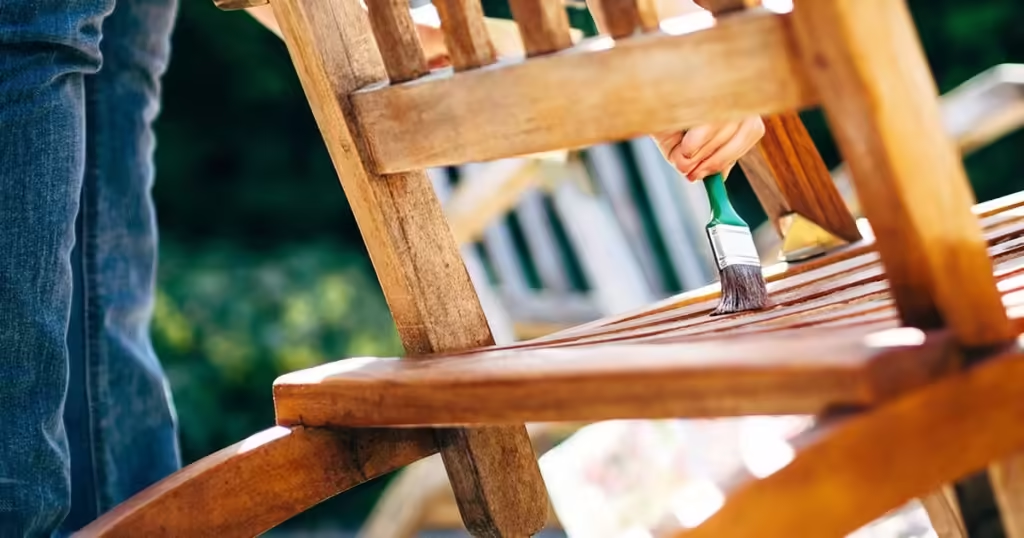
Additionally, if your furniture includes cushions or other fabric components, now is the time to wash and store them indoors. Cushions can deteriorate quickly if left out in freezing temperatures. After washing, store them in a dry, well-ventilated area to avoid mold and mildew buildup. I always pack mine in breathable fabric bags and keep them in my basement to keep them fresh and ready for the next season.
Best Practices for Covering and Storing
After your furniture is clean and prepped, it’s time to decide where and how you’ll store it. If you have the space, indoor storage is always the best option. A garage, shed, or even a basement can provide a dry, temperature-controlled environment that will keep your furniture safe from the elements.

However, I know not everyone has the luxury of indoor storage space. If you’re storing your furniture outside, using high-quality covers is essential. Choose covers that are weather-resistant and designed to fit your specific pieces. Avoid using generic plastic tarps, as they can trap moisture underneath and cause more harm than good.
One tip I always share is to elevate your furniture off the ground slightly. This can be done with blocks or pallets. Elevating your furniture helps prevent moisture from the ground from seeping into the legs or base of your furniture, which can cause rot or rust. Additionally, periodically check on your furniture throughout the winter to make sure the covers are still secure and there’s no water pooling on top of them.
For those who live in particularly harsh climates, it might also be worth considering more durable materials that are designed to withstand the winter elements. Furniture made from teak, aluminum, or synthetic wicker is generally more resilient and requires less intensive winter prep.
Finally, don’t forget to store any accessories, such as umbrellas, outdoor rugs, or decorative items. These items are often overlooked but can easily be damaged by winter weather. A little care now will save you the trouble and expense of replacing them next year.

Summer Maintenance Tips
When summer rolls around, your small patio furniture finally gets to shine. But before you dive into backyard barbecues and sunset cocktails, it’s important to give your furniture a little TLC to ensure it’s ready for the season. Summer weather, while generally more forgiving than winter, still presents challenges like intense sun, heat, and the occasional summer storm.
Cleaning and Refreshing Fabrics
One of the first things I do when preparing my patio for summer is giving the furniture a good deep clean, especially the fabrics. Cushions, pillows, and fabric chairs can accumulate a surprising amount of dirt and grime over the months, and no one wants to relax on a dirty cushion!
For fabric items, start by removing any covers that can be washed, and run them through the laundry on a gentle cycle with mild detergent. For the cushions themselves or fabric that can’t be removed, use a fabric cleaner designed for outdoor use. I’ve found that a mixture of warm water and a little dish soap works wonders for spot cleaning.
If your furniture includes outdoor rugs, now is the time to clean those as well. Shake out any loose dirt, then hose them down and scrub with a mild detergent. Be sure to let them dry completely in the sun to avoid mildew.
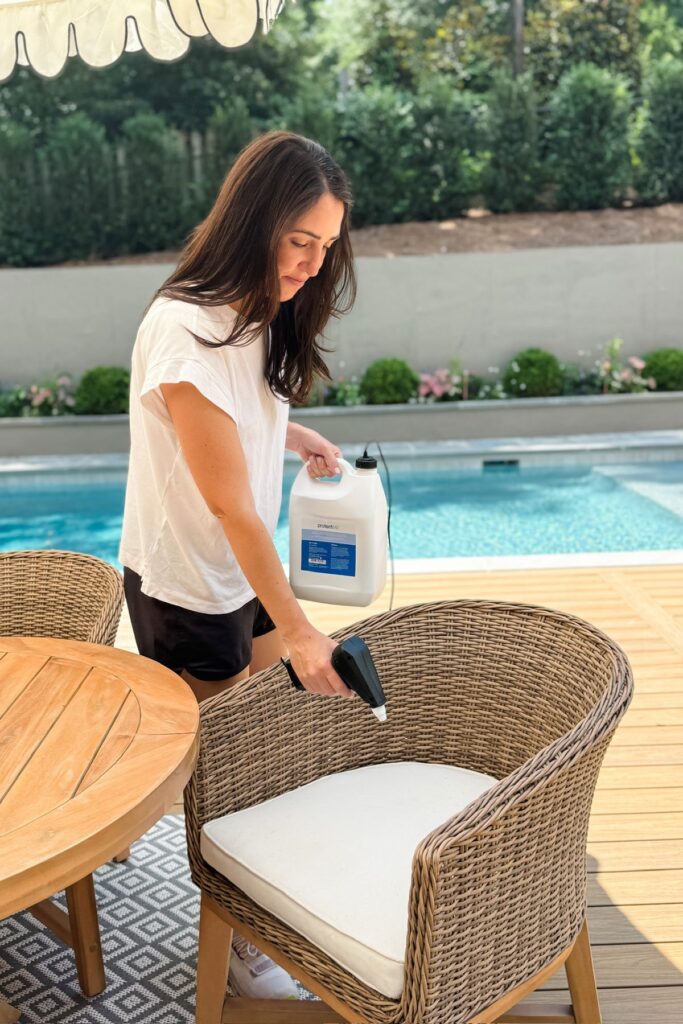
After cleaning, allow everything to dry completely in the sun. This not only ensures that your furniture is fresh and clean but also helps prevent mold and mildew from developing, which can happen if you store damp items.
Dealing with Sun and Heat Damage
Summer sun can be brutal, especially on materials like wood, plastic, and metal. UV rays can fade colors, dry out wood, and even cause plastics to become brittle. To combat this, consider investing in a patio umbrella or a shade sail. These not only provide comfort for you and your guests but also offer your furniture a break from direct sunlight.
For wooden furniture, a seasonal application of a UV-protective sealant is essential. This will help maintain the wood’s natural color and prevent it from drying out and cracking. Metal furniture can benefit from a periodic wipe-down with a cloth dampened with soapy water and a touch of car wax to create a protective barrier against the sun and heat.
Plastics, while generally more resilient to the elements, can still suffer from UV exposure over time. To extend the life of plastic furniture, clean it regularly with a gentle cleanser and keep it covered or stored in a shaded area when not in use.

Storm-Proofing Your Patio Furniture
Summer storms can come out of nowhere, and they can do some serious damage to your small patio furniture if you’re not prepared. Wind, rain, and hail can all take a toll, so it’s important to storm-proof your setup. Start by securing or storing any lightweight items like cushions, umbrellas, and small chairs. These can easily become projectiles in high winds, posing a danger not only to your furniture but also to your home. For heavier pieces that can’t be moved indoors, secure them with furniture anchors or heavy-duty bungee cords.

If a storm is in the forecast, it’s also a good idea to cover your furniture to protect it from the rain. As with winter storage, make sure the covers are secured tightly and that the furniture is slightly elevated to prevent water from pooling underneath.
Finally, after a storm passes, take the time to inspect your furniture for any damage. Wipe down any wet surfaces and let everything dry completely before using it again. This prevents moisture from seeping into materials and causing long-term damage.
Year-Round Maintenance Schedule
While seasonal care is crucial, maintaining your small patio furniture should be a year-round endeavor. Regular upkeep not only extends the life of your furniture but also ensures it’s always ready for use, no matter the season. Here’s a simple maintenance schedule you can follow to keep your patio looking its best throughout the year.
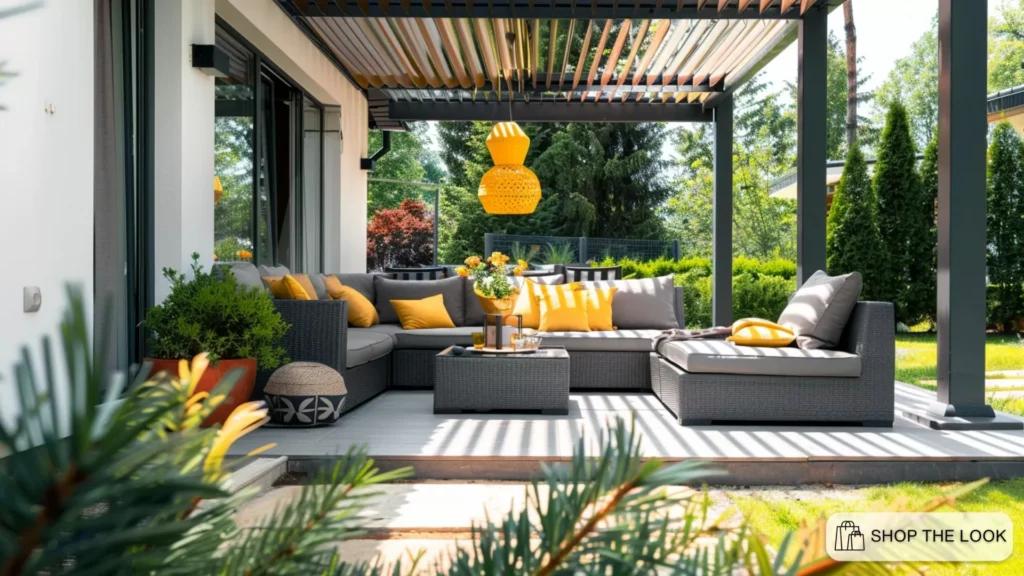
Spring:
- Deep Clean: Remove covers, clean fabrics, and wipe down all surfaces.
- Inspect for Damage: Check for any signs of wear or damage that may have occurred during winter storage. Repair or replace items as needed.
- Apply Protective Coatings: Refresh wood sealants, rust inhibitors, and UV protectants.
Summer:
- Monthly Cleaning: Regularly clean fabrics, wipe down surfaces, and check for any signs of sun or heat damage.
- Reapply UV Protectants: Depending on exposure, you might need to reapply protective coatings, especially on wood and metal furniture.
- Monitor Weather Conditions: During particularly hot or stormy periods, consider covering or moving furniture to a more protected area.
Fall:
- Prepare for Storage: Start prepping your furniture for winter storage by giving everything a thorough clean.
- Inspect Covers: Make sure your covers are in good condition and replace any that are worn or damaged.
- Seal Wood: Apply a final coat of sealant to wooden furniture to protect it from winter moisture.
Winter:
- Check Covers Periodically: Throughout the winter, check your furniture covers to ensure they remain secure and that there’s no moisture buildup.
- Inspect for Pests: Make sure no critters have taken up residence in your stored furniture.
- Ventilation: If you’re storing cushions or fabric indoors, ensure they’re in a well-ventilated space to prevent mildew.
Quick Repair Tips for Common Issues
Sometimes, despite our best efforts, things can go wrong. Here are some quick fixes for common patio furniture issues that can crop up throughout the year:
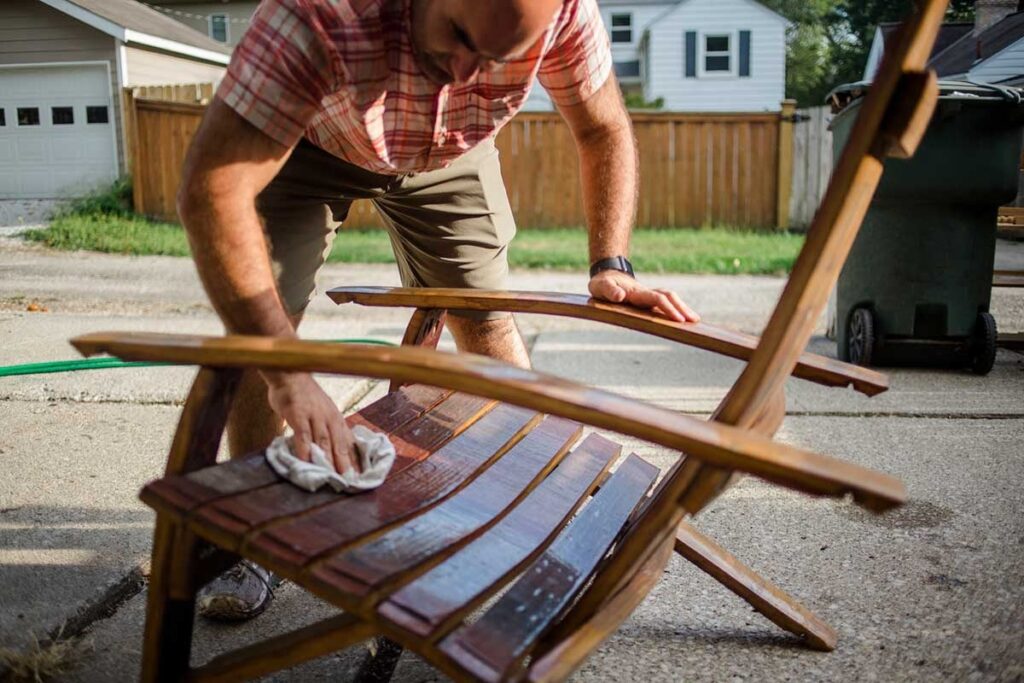
- Rust on Metal Furniture: If you notice rust spots beginning to form on your metal furniture, tackle them as soon as possible. Use a rust remover or a mixture of baking soda and water to scrub away the rust. After cleaning, apply a coat of rust-inhibiting spray paint to prevent it from coming back.
- Cracks in Wooden Furniture: Small cracks can appear in wooden furniture over time, especially if it’s exposed to extreme weather conditions. To fix these, use a wood filler that matches the color of your furniture. Once the filler is dry, sand it down and apply a fresh coat of sealant.
- Fading Fabrics: If your outdoor cushions or umbrellas are starting to fade, you can often revive them with a fabric dye specifically designed for outdoor use. Another option is to rotate your cushions regularly to ensure even wear.
- Wobbly Furniture: Over time, screws and bolts can loosen, making your furniture wobbly. Regularly check and tighten all fasteners. If a piece of furniture continues to wobble, consider adding additional support, such as furniture brackets or leg braces.
Taking the time to care for your small patio furniture throughout the year not only preserves its beauty but also extends its lifespan, allowing you to enjoy your outdoor space for many seasons to come. Remember, a little maintenance goes a long way, and with these tips, your small patio furniture will remain a charming and functional part of your home.
Disclosure: Our blog contains affiliate links to products. We may receive a commission for purchases made through these links. However, this does not impact our reviews and comparisons. We try our best to keep things fair and balanced, in order to help you make the best choice for you.


